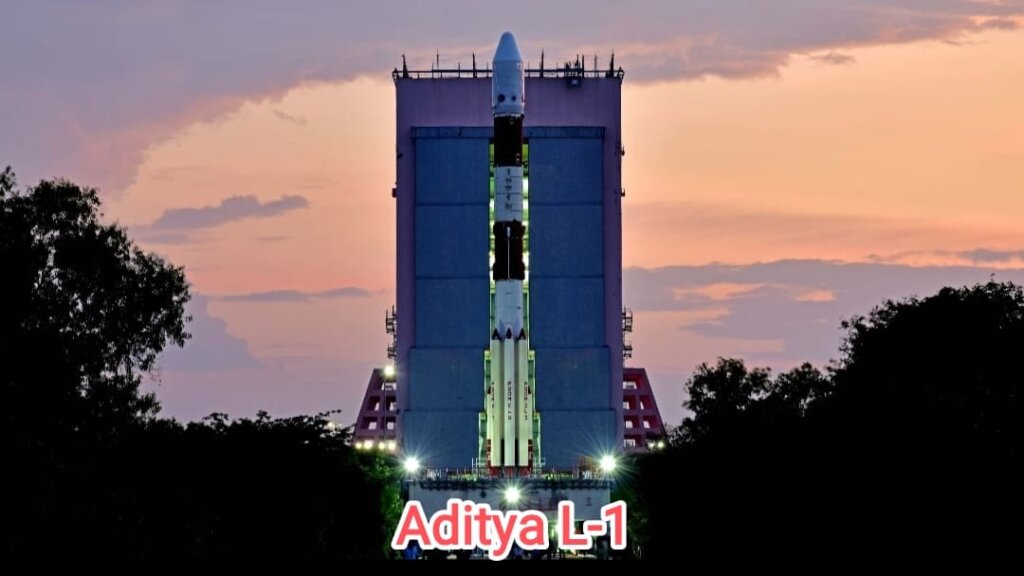Aditya-L1 Solar Mission ISRO: The launch is scheduled on 2nd September, 2023 at 11:50 am
Aditya L1 shall be the first space grounded Indian charge to study the Sun. The spacecraft shall be placed in a halo route around the Lagrange point 1( L1) of the Sun- Earth system, which is about1.5 million km from the Earth. A satellite placed in the halo route around the L1 point has the major advantage of continuously viewing the Sun without any occultation/ declines. This will give a lesser advantage of observing the solar conditioning and its effect on space rainfall in real time. The spacecraft carries seven loads to observe the photosphere, chromosphere and the remotest layers of the Sun( the nimbus) using electromagnetic and flyspeck and glamorous field sensors. Using the special edge point L1, four loads directly view the Sun and the remaining three loads carry out in- situ studies of patches and fields at the Lagrange point L1, therefore furnishing important scientific studies of the propagatory effect of solar dynamics in the interplanetary medium
કેન્દ્રીય કર્મચારીઓના DA માં 4% વધારાનો સંકેત બાબતના સમાચાર અહીથી વાંચો
The suits of Aditya L1 loads are anticipated to give utmost pivotal informations to understand the problem of coronal heating, coronal mass ejection,pre-flare and flare conditioning and their characteristics, dynamics of space rainfall, propagation of flyspeck and fieldsetc.
Science Objectives: The major wisdom objects of Aditya- L1 charge are
Study of Solar upper atmospheric( chromosphere and nimbus) dynamics.
Study of chromospheric and coronal heating, drugs of the incompletely ionized tube, inauguration of the coronal mass ejections, and flares
Observe the in- situ flyspeck and tube terrain furnishing data for the study of flyspeck dynamics from the Sun.
drugs of solar nimbus and its heating medium.
Diagnostics of the coronal and coronal circles tube Temperature, haste and viscosity.
Development, dynamics and origin of CMEs.
Identify the sequence of processes that do at multiple layers( chromosphere, base and extended nimbus) which ultimately leads to solar eruptive events.
glamorous field topology and glamorous field measures in the solar nimbus.
motorists for space rainfall( origin, composition and dynamics of solar wind.
Aditya-L1 Payloads:
The instruments of Aditya- L1 are tuned to observe the solar atmosphere substantially the chromosphere and nimbus. In- situ instruments will observe the original terrain at L1. There are total seven loads on- board with four of them carrying out remote seeing of the Sun and three of them carrying in- situ observation.
Payloads along with their major capability of scientific disquisition.
TypeSl. No.PayloadCapabilityRemote Sensing Payloads 1 Visible Emission Line Coronagraph(VELC) Corona/Imaging & Spectroscopy
2 Solar Ultraviolet Imaging Telescope (SUIT) Photosphere and Chromosphere Imaging- Narrow & Broadband
3 Solar Low Energy X-ray Spectrometer (SoLEXS) Soft X-ray spectrometer: Sun-as-a-star observation
4 High Energy L1 Orbiting X-ray Spectrometer(HEL1OS) Hard X-ray spectrometer: Sun-as-a-star observation
In-situ Payloads
5 Aditya Solar wind Particle Experiment(ASPEX) Solar wind/Particle Analyzer Protons & Heavier Ions with directions
6 Plasma Analyser Package For Aditya (PAPA) Solar wind/Particle Analyzer Electrons & Heavier Ions with directions
7 Advanced Tri-axial High Resolution Digital Magnetometers In-situ magnetic field (Bx, By and Bz).

Find satellite images of any location. Discover cities and mountains with tours
Find satellite images of any location. Discover cities and mountains with tours.
composed of the Mediterranean Sea (between Europe and Africa), the Nile River (between Africa and Asia) and the Don River (between Europe and Asia). The Nile and the Don meet in a single line to form the top of the During these Dark Ages in Europe, Arab scholars kept scientific cartography alive. They preserved the works of Ptolemy and translated them to Arabic. Arab cartographers produced the first reliable globe of the Western world.
Find satellite images of any location. Discover cities and mountains with tours
During the Islamic Golden Age, Arab cartographers used complicated mathematical and astronomical formulas to help them determine different map projections. In 1154, the scientist and cartographer al-Idrisi made a map of the world that was better than the world maps Europeans were producing. Al-Idrisi’s map included a representation of the entire continent of Eurasia, including Scandinavia, the Arabian Peninsula, the island of Sri Lanka, and the Black and Caspian Seas.
In the fifteenth century, cartography in Europe improved. The development of printing and engraving meant maps that had previously been painted by hand could be copied more quickly. Around the same time, sailors began traveling farther on the oceans. They added newly discovered lands and more detailed coastlines to their maps. Explorers brought back descriptions of the interiors, as well as the coastlines, of continents.
Europeans explored much of the Americas during the sixteenth century, Australia in the seventeenth century, and Antarctica was finally sighted in the early nineteenth century. At this point, fairly accurate maps of the entire world were beginning to be assembled.
In the nineteenth century, cartography became more advanced with the development of a printing process called lithography. Lithography allowed cartographers to make many accurate copies of maps with less labor and expense.
Photography, color printing, and computers all improved mapmaking even more. In just a few decades, the relationship between people and maps changed drastically. For example, instead of using paper street maps, many people navigate using GPS units that communicate with satellites to determine their exact location on Earth. Digital versions of maps can represent Earth in three dimensions, defying the limitations of the flat maps of the past. Almost the entire surface of Earth has been mapped with remarkable accuracy, and this information is available instantly to anyone with an internet connection.
Chandrayaan 2 by contacting the population module of this orbital directly with the IDSN.
પૃથ્વી અને ચંદ્ર બંને એકસાથે દેખાયા, ISROએ શેર કર્યો જુવો આદિત્ય L1નો નવો વીડિયો
પૃથ્વી અને ચંદ્ર બંને એકસાથે દેખાયા, ISROએ શેર કર્યો જુવો આદિત્ય L1નો નવો વીડિયો


